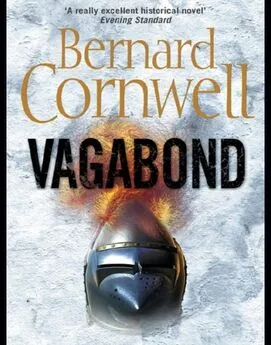Leo Frankowski - CONRADS QUEST FOR RUBBER
- Название:CONRADS QUEST FOR RUBBER
- Автор:
- Жанр:
- Издательство:неизвестно
- Год:неизвестен
- ISBN:нет данных
- Рейтинг:
- Избранное:Добавить в избранное
-
Отзывы:
-
Ваша оценка:
Leo Frankowski - CONRADS QUEST FOR RUBBER краткое содержание
CONRADS QUEST FOR RUBBER - читать онлайн бесплатно полную версию (весь текст целиком)
Интервал:
Закладка:
Yet he was not lacking in zeal, and whenever he spoke about the future, when he would have a chance to convert the heathen to Christ, you could see a certain light come on in his eyes. It was a beautiful light, but sometimes it was also a frightening one.
Toward the end of the course, almost as an afterthought, we were issued firearms of a new and interesting sort. The powder charge in the old, heavy swivel guns was ignited by a "firecracker" wick at the back of the cartridge that was lit by an alcohol flame. This was good enough when you knew a battle was coming, but it could be very awkward when unexpected things started to happen quickly.
The new guns were handheld rather than mounted, and were much lighter, about ten pounds for the rifle and three for the pistol. Ignition was by a piezoelectric crystal in the stock which, when struck by a small hammer, put an electric current through a spark plug at the back of each cartridge.
The pistol was a single-shot, break-action affair, while the rifle had a seven-shot, spring-fed clip and a bolt action. We were issued new knives with the rifles, called bayonets, which fastened to the end of the barrel, making the weapon usable as a short pike. All told, it was a remarkably well-thought-out weapon system, and we were proud to be the first unit to be issued it.
Graduation involved both written and oral examinations, and a number of practical tests as well. One of them involved being dumped naked and alone in a forest in the early spring, and being expected to build yourself suitable shelter, to make yourself suitable tools, clothing, and weapons, and to find or kill sufficient food to keep yourself alive for two weeks. They actually weighed you before and after the test, and you lost points if you lost weight!
In the end, everyone in my lance graduated, and most of the others did, too. We had a nice commencement ceremony with everyone in our eight-pounds-of-gold uniforms, and they handed out illuminated certificates to us with our friends and parents watching.
Well, parent, in my case, since my father refused to attend.
Most important for Sir Odon and all his loyal men was the fact that with graduation, our long-awaited promotions had at last come through. I was now Sir Josip, at eight pence a day, and Sir Odon was now a knight-banner, at twice that, with the right to use a triangular flag on his cavalry lance, if he ever got one, or, indeed, if he ever got a horse.
This made for some unusual ranks in our charts. The lowest rank in the Explorer's Corps was a knight, and the lance leaders were all now knight-banners. In theory, we were organized in the usual six lances to the platoon, but since each lance would be acting independently, there were no platoon leaders. Lance leaders reported directly to the company commander.
And our company commander was not the usual captain, but Baron Siemomysl himself.
Still, nobody ever said that the army had to be absolutely consistent. In the Wolves, who are made up entirely of members of the old nobility, the lowest rank is also the knight, and platoons are led by captains.
The next day, we were loaded into six chartered riverboats for the trip north. The reason for this seemingly lavish excess of transportation was that each explorer lance had an entire war cart filled with its supplies for our upcoming adventure. That was eighteen cubic yards, a ton and a half per man.
Besides our personal gear, which included everything from our armor and weapons to a year's supply of underwear and toothpaste, we had a wide variety of preserved food, enough to feed us all for three years. The trip home might be delayed, or we might have to feed a hungry tribe in the winter.
We also carried a wide variety of trade goods — tools, weapons, jewelry, cloth of many varieties, glassware, needles, fishhooks, books, even toys and games.
In a special strongbox, each lance was equipped with a large supply of money, a quarter of a million pence, equivalent to ten years' pay for every man in the lance. Some of it was in gold, some in silver, and some in the army's own zinc coinage. Sir Odon was responsible for accounting for every bit of it.
We made the trip north to Gdansk, where our new ship, the Baltic Challenger, was completing its first shakedown cruise. We drank and sang and partied the whole way and had about as much fun as an all-male group can possibly have.
At one point we got the riverboat's regular crew so drunk that they couldn't stand, much less operate the boat, and then my lance took the thing over and ran it until the next morning, when the regular crew woke up.
Through the night, we had sent out dozens of strange, rude, or downright obscene radio messages, and the next day the regular crew couldn't blame it on us without confessing to being drunk on duty. They were in a lovely pickle when we finally bid them good-bye.
Chapter Fourteen
From the Journal of Josip Sobieski
WRITTEN FEBRUARY 1, 1249, CONCERNING MAY 10, 1248
THE BALTICChallenger got back to Gdansk after her shakedown run the day after we arrived, and almost the entire Explorer's Corps was on the dock to cheer her in. Most of us got there early, and at first all we could see of our new ship was a dot on the horizon that our telescopes couldn't do much to resolve.
It was a clear day, and we could see across the Vistula Lagoon and far out into the Baltic. Quite a while went by before we realized that we were looking at her smokestack. The rest of her hull appeared to be below the horizon, and eventually the realization hit us that we were actually seeing proof with our own eyes that the world was indeed round!
In the course of an hour she both grew and seemed to rise out of the water, to become of respectable size, and although we were seeing her at her smallest, from head on, we grew increasingly impressed with the engineering feat she represented.
We had all seen drawings of her, of course, and knew her specifications by heart. She was five dozen yards long at the waterline and six dozen yards long overall. She was almost two dozen yards wide and three dozen yards tall, from her keel to the top of her radio tower.
Her speed was an incredible one and a half gross miles a day, so fast that if the world were all ocean, she could circumnavigate the globe in only four months! Her fuel tanks were big enough to let her do it nonstop! Her normal fuel was oil, but in a pinch, her boilers could burn coal or even wood.
Her nine long cargo holds could hold two gross containers, compared to the six that our standard riverboats could handle. What is more, the containers used were mounted on half nuts, and these rested on large screws that ran the length of the cargo holds. Cargo could thus be easily shifted while the ship was under way, and those containers needed at the next port could be made ready for rapid discharge.
She had evaporators aboard that used engine waste heat to produce fresh water for the boilers and for use by passengers and crew. The same evaporators also produced sea salt, a salable commodity.
She carried two steam launches aboard, and eight container-sized barges that could be towed into the shallowest water. The Baltic Challenger could take on and discharge cargo and passengers without needing any port facilities beyond a simple crane. A war cart could be put ashore without even that.
But seeing technical drawings and reading specifications, even if they were astounding, could not prepare us for the sheer immensity of the glorious machine in front of us. As she came closer and closer, she grew and grew, and I had to keep telling myself that she was still far away!
Finally, she turned into the lagoon, and we could see her whole majestic flank from the side. Her hull was bright red, and her topsides were white, except for the streamlined red smokestack with its white Piast eagle.
She was a magnificent sight, and as she backed into her stall between two huge docks, she towered over us. It became my urgent desire to run aboard her and examine her from stem to stern, like a wonderful new lover found after a long and lonely trip.
But such was not to be. My lady had many other lovers besides me, and most of them vastly outranked me in the army's scheme of things. Lord Conrad was there, high above me on the reviewing stand. He had with him at least two dozen of his barons, and his liege lord, King Henryk himself, beside him. There was a crowd of foreign dignitaries up there, too, and it was easy to imagine why they had been invited. If anything could impress a foreign government of our power and wealth, this incredible ship would do it!
Annoyingly, the men of the Explorer's Corps, the very people the Baltic Challenger had been built for, after all, were not allowed aboard until late in the day. Even then, we were put ashore within the hour, before we had seen a twelfth of what we wanted to see.
Our departure date was put back by three days while Lord Conrad and King Henryk took the foreign dignitaries, three of whom turned out to be kings in their own right, out on a pleasure jaunt.
Politics!
Still, there was much to see around the new harbor and the huge shipyard. The ferrocrete hull of the Challenger had to be built indoors, out of the weather in a dry dock that was necessarily much bigger than the ship itself. The woman showing us around bragged that the naves of six cathedrals the size of Notre Dame, currently being built in Paris, could be placed side by side inside the dry dock without crowding. The dock's great overhead crane, a masterful engineering work, could have picked any one of them up, and turned it sideways! Notre Dame had been eighty years in the building and was not yet finished, while the dry dock had been completed in less than two years.
In the dry dock, work had begun on the Atlantic Challenger, sister ship to the Baltic Challenger. They hoped to build them at the rate of two a year for the next five years, at least.
The entire corps spent a day with the master shipwright, while he explained the difficulties of making a huge ship out of steel and concrete, and what one had to do to be sure that it was all one, seamless piece.
The sheer scale of things at Gdansk and the precision with which such huge things were made so impressed us that we were almost tempted to apply to work there. Almost, but not quite.
Finally, we were ready to get under way, and the plan was to explore the lands around the Baltic Sea.
Admittedly, it was not a very ambitious project, since the Baltic probably didn't need exploring, but they told us that you have to start somewhere. True, there were plenty of Christian ships already there, and while they were little wooden things, they were well-organized, with their own political setup: the Hanseatic League. There were plenty of Christian seafarers around who could navigate to any of the ports in the area, and indeed we did have two such pilots aboard, to advise Baron Tados, our ship's captain, but what can you do?
It wasn't my idea, anyway.
Looking at Lord Conrad's sketched maps of the world, the Baltic seemed to be so close and so small that we felt we would be like little boys camping out in their mother's herb garden, but ours was not to reason why.
Left to ourselves, the corps would probably have steamed off to Africa, where they say the people all have black skins, or to Hy Brazyl, or to some other romantic-sounding place shown on Lord Conrad's roughly sketched maps, but we were ordered to start with the Baltic, and being good, obedient young men, that was what we would do.
Next year, maybe we'd steam to China.
On the fourteenth of May 1248, we set forth at dawn to discover the world, but, like I said, just the Baltic this year. We left Gdansk and the ship headed east, to circumnavigate the Baltic, counterclockwise.
Читать дальшеИнтервал:
Закладка:


![Робин Хобб - Странствия Шута [Fool’s Quest]](/books/1086209/robin-hobb-stranstviya-shuta-fool-s-quest.webp)




